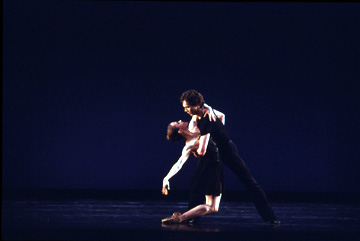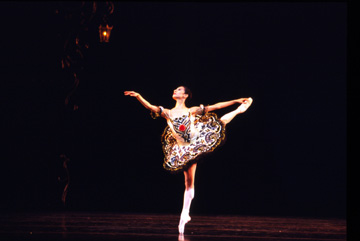Tomasson's 7 for Eight: Stainless Steel and Angelic Grace
Paquite,
7 for Eight,
Le
Carnival des Animaux
San Francisco
Ballet
War Memorial Opera House
San Francisco, California
February
24 , 2004
by
Paul Parish
Copyright © 2004
by Paul Parish
published 1 March 2004
 It
often seems to me that we've arrived in the dance world at a stage very
like that which succeeded the great age of Elizabethan drama—after
Marlowe, Shakespeare, and Jonson, what follows is a generation that's
hyper-aware of what's been done, and the gifted among them, the Fletchers
and the Websters spend their wits making madder mad scenes, more villainous
villains, elaborating self-consciously on the affective devices that made
King Lear so involving, so upsetting it made grown men cry.
It
often seems to me that we've arrived in the dance world at a stage very
like that which succeeded the great age of Elizabethan drama—after
Marlowe, Shakespeare, and Jonson, what follows is a generation that's
hyper-aware of what's been done, and the gifted among them, the Fletchers
and the Websters spend their wits making madder mad scenes, more villainous
villains, elaborating self-consciously on the affective devices that made
King Lear so involving, so upsetting it made grown men cry.
Similarly in the wake of the heroic generation (Balanchine, Graham, Ashton, Limon, name your favorites), we get dances that live in the suburbs of the masterpieces they created. It's nobody's fault—it's just where we are in the cycle. Today the technique has flowered to the point where the practitioners are so adept they are almost in advance of what the idea-folk can ask of them.
So you hear that Helgi Tomasson is going to make a ballet to Bach, what do you expect? Well, it won't have the organic, fated quality of Concerto Barocco, the structure will not make form reveal function—but I expect that the dancers will move to that music with a grace bordering on the angelic.
And that's exactly what's happened. Two visits to San Francisco's fourth program have not exhausted my fascination with Helgi Tomasson's new octet, a suite of dances called 7 for Eight set to keyboard-concerto music of Bach's arranged (mostly) for piano and orchestra. The piece actually looks like a piano sounds: it gleams like stainless steel, with a tremendous variety of effects.
While I'm not tempted to claim that the choreography is great, I'd have to say that it's often brilliant, and it is extremely grateful for dancers. We need a word for dancers that corresponds to "pianistic," that quality (in Chopin's music, for example) where the music fits so miraculously with what the fingers would want to do of themselves on a keyboard. Tomasson's combinations, difficult though they are, lie so easily and gracefully under his dancers' feet. I've rarely in my life seen dancing so fluent and air-borne as is the almost constant state in this new work. Tina leBlanc and Gonzalo Garcia are not to be believed, their forms are so clear, so charged, and yet so at ease in these quicksilver configurations. Each of them, in very different ways, made me feel like I'd never seen dancing before—leBlanc in particular can make a sudden change of direction seem to stop time altogether. In full flight round the room she turns her head and steps into a balancé that's so centered, so calm, it seems she's alit in the valley of love and delight. Then she extends her foot and she's off again, but always with such an equilibrium in her person that she carries you with her effortlessly.
The piece does hold together with the loose affinities of a suite, and has a considerable coherence of atmosphere (greatly assisted by Sandra Woodall's wonderful costumes, which are studies in black that might have held the interest of Whistler—black lace basques with filmy black chiffon skirts for the women, and simple tight black trousers and shirts for the men). The plastique is relatively unrotated, the ballerina image often reminded me of Bessmertnova, sleek, bird-like, especially in the two mysterious adages. Both Yuan-Yuan Tan and Julie Diana were beautiful in these, though I find Diana more satisfying, since she is more musical, the moment her foot touches down ending the phrase can be very satisfying.
There are seven movements loosely fitted together. The first and sixth are adagio pas de deux, the fifth is a mercurial solo (set to the only section scored for harpsichord) that resembles a little the Boy in Brown's flights round the space in Dances at a Gathering—light cabrioles and many quick running steps, or feathery jetés and many quick running steps, or jetés flying backwards and many quick running steps—interrupted by abrupt questioning poses…. Both Joan Boada (first cast) and Pascal Molat made fleet magic out of this, so the virtuosity was completely subsumed in the phrasing; it is the finest dancing of this sort I've yet seen from Boada and (I'd say this with more confidence if I really thought I'd seen enough of his dancing to venture such a judgment) represents a real extension of his mastery.
The ballet is dream-like, and occurs half in the dark—rather like a night troubled with consciousness, though not unpleasantly. A trio flits through. Elizabeth Miner's golden hair floated above this in a heavenly way, she had moments of miraculous suspension and quiet, (again in combinations that flew by at high speed)—but it's not always the same man, the feeling is constantly shifting.
Le Blanc (and Miner in the smaller role) actually hold their own against the men—but the glory of SFB is now its men. Gonzalo Garcia's dancing in this piece eats up the stage in a way I don't think I've seen before—it is not heroic so much as angelic, and even Ib Andersen's dancing looks human compared to this. There is never a preparation, never a bounce or rebound; he barely touches down but to take off again. Taglioni must have been like this; the figure is always in the air. He goes up in the position of a kid doing a cherry bomb—knees tucked up into his shoulders, head looking backwards—at the top of his trajectory, the whole configuration unfolds, his head turns as a leg darts sideways, and he sails off lightly. The whole thing is a miracle of lightness; he uses the air, as Sibley said of Baryshnikov, the way other dancers use the floor—except this is so much lighter than Baryshnikov. He's built rather like him: short muscular legs, narrow rib-cage, good-sized head, remarkable eyes in an open, charming face.
But Garcia was not the only man in the piece—and indeed, perhaps not even the main man. He was paired with the extraordinary new soloist Nicholas Blanc for a duet where multiple grand pirouettes swelled and spiraled into ravishing vortices, marvellously congruent with each other. This is dancing "like music"—as when (say) two violins wrap their melodies around each other.
7 for Eight was the most satisfying piece on the program, which was a mixed bill including Makarova's awkward staging of Paquita.
 From
the opening mazurka and cracovienne steps, this Paquita seemed
to be court dancing where everyone must look cheerful but is in fact scared
to death. It just looks hard to dance like that. The tempi are uncomfortable,
too slow for some steps but too fast for others; the phrases are awkward,
and it's all so difficult. Guennadi Nedviguine drew cheers for his mastery
of a circle of beaten steps (sissonne coupe assemblé, except all
the sissonnes were beaten like entrechat-six)—which is appropriate,
since it's really more an exercise than it is a dance phrase. Which is
not to detract from Nedviguine's clarity. He is a wonderful dancer, and
it is so good to see him back on the stage again after his long injury-related
absence last year.
From
the opening mazurka and cracovienne steps, this Paquita seemed
to be court dancing where everyone must look cheerful but is in fact scared
to death. It just looks hard to dance like that. The tempi are uncomfortable,
too slow for some steps but too fast for others; the phrases are awkward,
and it's all so difficult. Guennadi Nedviguine drew cheers for his mastery
of a circle of beaten steps (sissonne coupe assemblé, except all
the sissonnes were beaten like entrechat-six)—which is appropriate,
since it's really more an exercise than it is a dance phrase. Which is
not to detract from Nedviguine's clarity. He is a wonderful dancer, and
it is so good to see him back on the stage again after his long injury-related
absence last year.
But the ballet is made so that his clarity makes the Prince look bad. When it came to the virtuoso finale, Pierre-François Villanoba (also recently back from an injury) actually looked afraid, and the vibe was scary when Yuan-Yuan Tan began her fouettés. The last eight had me white-knuckled on her behalf, though she made it through both Thursday and Saturday (and on Saturday she pulled a triumphant balance in sous-sus out of her finish). Tan can do 32 fouettés—I've never worried about her before (well, yes I have, but it's been years). But the whole ballet had failed to build up a satisfying dance-rhythm across its whole sweep, although individual sections had worked out well. Many of the corps had been lucky in their assignments, especially Megan Lowe and Joanna Mednick, and Tina leBlanc was fabulous in the infamous third variation, with repeated grand pirouettes alternating between arabesque and attitude—she made them look not only easy but beautiful. The ballerina, Yuan Yuan Tan, was gorgeous in her variation, while everyone was valiant; still it never could get going.
A word about Yuan Yuan Tan. She is a beautiful woman, dark of hair and eyes with a tiny head, small rib-cage, long and light of limb, with long feet and very long toes. She doesn't use her feet elegantly but once on pointe she is the most glamorous thing imaginable, which I admire especially because she does not sell her glamor and is noble by temperament. She is not very musical but has a considerable gift for tragedy. (She made a brave woman, a real heroine out of Desdemona, and as the Girl in Mauve, in Dances at a Gathering, she made something tremendous out of the B Minor scherzo.)
It was wonderful to see Tan's plastique in Paquita. Her legs have wowed us since first we saw her, as Esmeralda; but her upper body is equally capable of enchanting plastic effects. She began Paquita's variation with her back arched and arms in "Spanish fourth," carving out the most magnificent spiral I've ever seen; she really made me think of Fanny Ellsler. Throughout this dance I felt I was in the presence of a character: a princess who'd been captured by gypsies. Her entire upper body participated in those ravishing changes of épaulement, where she steps along the whole diagonal "washing her arms." I would have loved to have felt that throughout.
The program concluded with Alexei Ratmansky's Le Carnival des Animaux (a comedy I don't find funny, though Sherri leBlanc was marvelous as the elephant, and Muriel Maffre as the swan). The audience loves it.
Photos
(both by Andrea Flores)
Gonzalo Garcia and Tina LeBlanc in Tomasson's 7 for Eight
Yuri Possokhov and Yuan Yuan Tan in Tomasson's 7 for Eight
Originally
published:
www.danceviewtimes.com
Volume 2, Number 9
1 March 2004
Copyright ©2004 by Paul Parish
|
|